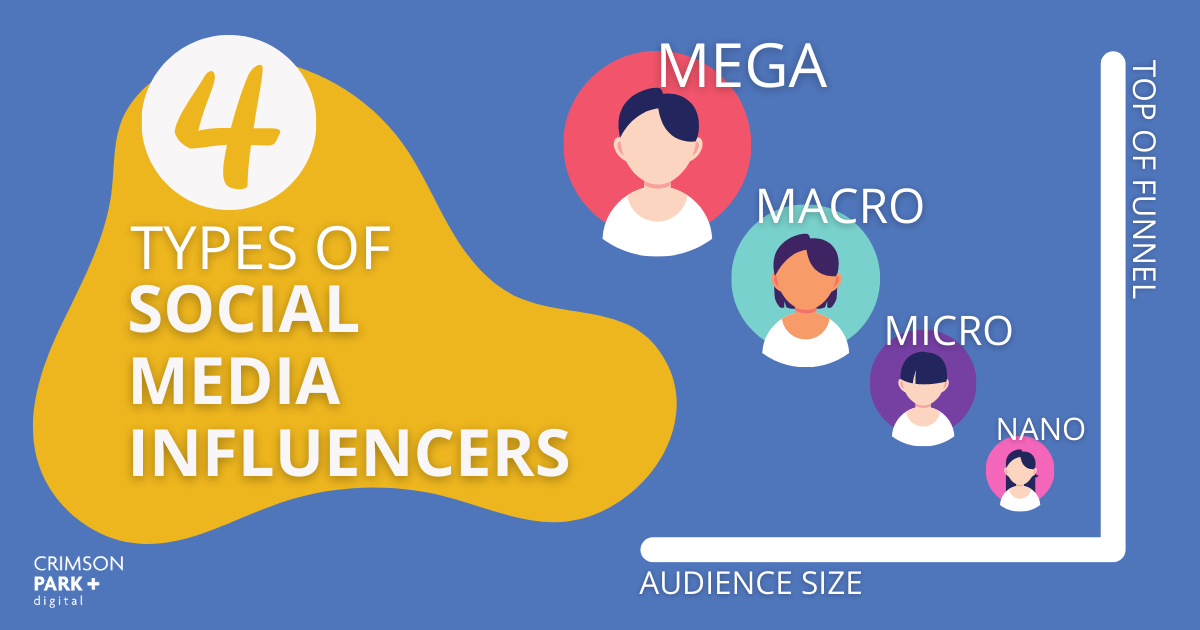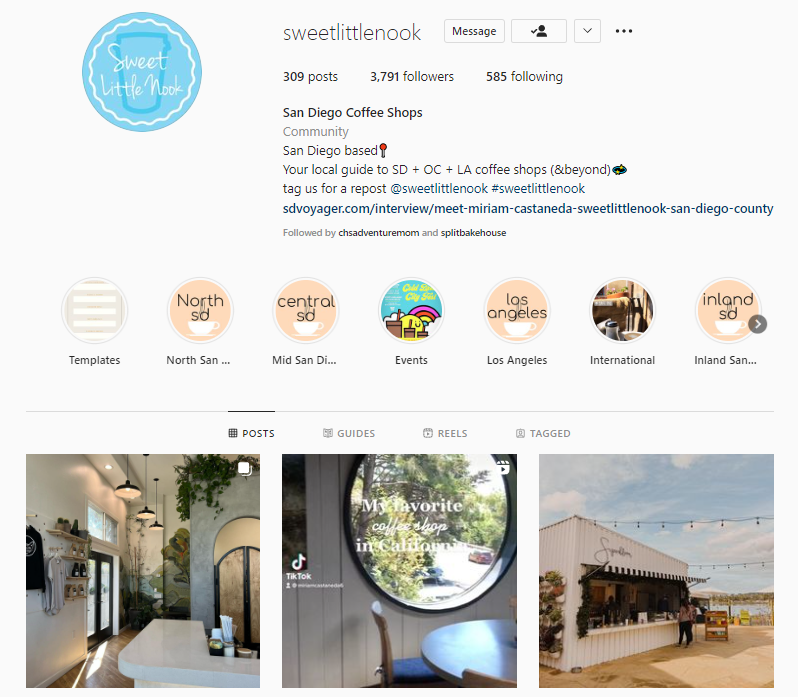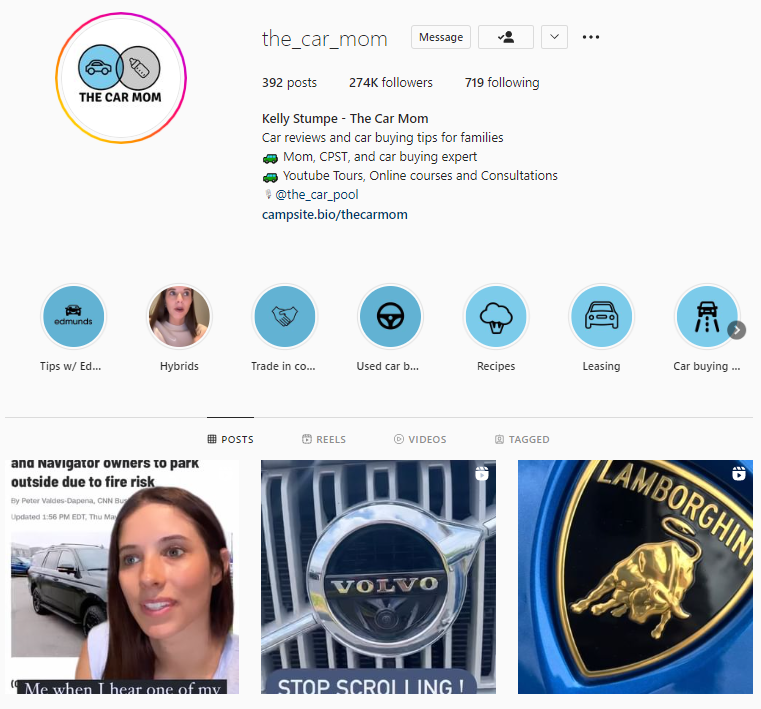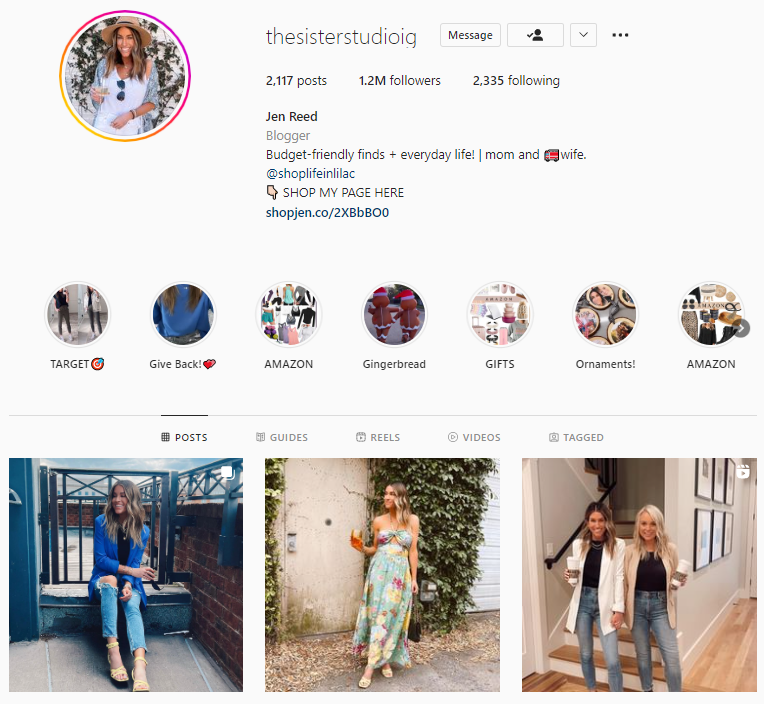The 4 Types of Social Media Influencers
So you’ve done your research and you’ve realized that influencer marketing is the next facet of content marketing that your company needs to adopt. While scrolling through influencer options in your brand’s industry or niche, you may have come across designations such as nano influencer or macro influencer, but what’s the difference?
There are 4 types of social media influencers, based on their amount of profile followers:
- Nano: 10,000 followers or fewer
- Micro: 10,000 – 100,000 followers
- Macro: 100,000 – 1 million followers
- Mega: Over 1 million followers
Understanding the nuances between these types of social media influencers, and the pros and cons can help you make the most strategic choice for your business and set your campaign up for success.
Nano Influencers
Nano influencers have anywhere from 1 to 10,000 followers on their social media channels. What sets this group apart from other types of influencers is that their following is mostly composed of their own community members. They may have a following of locals due to a status position in the local government, neighborhood, or a group within those communities.
Nano Influencers are touted as “regular people” who can bring a brand to the immediate attention of their concentrated audience. These individuals are more likely to create their own content, presented in an extremely authentic way.
The Pros of Using Nano-Influencers
- Credibility – Nano-influencers generally know their followers on an intimate level, so the brands they partner with are well received–especially when the brand aligns with the group’s niche or location.
- Locality – Partnering with a nano-influencer to promote a shop’s location or local event can be an especially effective way to increase awareness within the local community.
- Low cost – The low cost of working with nano influencers makes this partnership attainable for small businesses or those with low marketing budgets.
- High Engagement – Because this group’s followers are most likely people they interact with within the real world, they have the highest engagement out of the other types of influencers.
- Increased Conversions – High engagements lead to higher conversion rates due to followers’ innate trust for nano influencers. It’s easy to see how people would trust someone they know personally more than a celebrity or mega influencer.
The Cons of Using Nano Influencers
- Lack of experience – Due to their smaller following, nano-influencers may not understand the benefit they can bring to brands and thus create less professional content. This may mean that a little more responsibility falls onto the brand to guide the campaign’s content ideas.
- Low Reach – Nano influencers’ reach is the lowest of the influencer groups which means you may need to partner with multiple nano-influencers in a community or create supplemental campaigns to make a strong impact.
- Hard to Find – Finding an influencer with this type of following may require more preliminary research on your part, to ensure you’re reaching the correct audience.
An Example of a Nano Influencer
An example of a nano influencer is @sweetlittlenook. With just under 4,000 followers, this San Diego-specific coffee shop community page is incredibly specific in content type and would likely garner comparatively high engagement rates – especially due to its localized nature.
Micro-Influencers
Micro-influencers are the most commonly found type of social media influencer and have followings between 10,000 and 100,000 people. Micro-influencers typically focus on a specific niche, industry, or culture, and are regarded as subject matter experts. While their relationship with their followers may not be as intimate as that of nano influencers, they have stronger follower relationships than that of the two biggest types of influencers.
Micro-influencers generally have an audience that is uniform in their thoughts or demographics, so their followers are always interested in what they have to say. This appeals to brands who want to reach a specific audience with high engagement rates.
The Pros of Using Micro-Influencers
- Availability – This group of influencers is the most available for partnerships and can generally be accessed directly rather than through a management agency.
- Affordability – Though more expensive than nano influencers, micro-influencers are relatively affordable–enabling businesses to partner with several at a time.
- High Engagement and Conversions – Micro-influencers have a following that relates to their niche and thus trust the brands these influencers promote. High engagement can lead to high conversion rates, making this a smart choice for brands looking to convert in specific ways.
The Cons of Using Micro-Influencers
- Moderate Reach – If brand awareness is your company’s only goal, you’ll have to partner with multiple micro-influencers to increase reach. The smaller-sized audiences of micro-influencers better serve brands with conversion-specific goals.
- Inconsistent Content Quality – Because this group of influencers is generally operating independently from a management agency, it’s important to establish terms of service and quality standards to avoid content that doesn’t fit your brand.
An Example of a Micro-Influencer
An example of a micro-influencer is Elaine of @ncmodernfarmhousedesign. With just over 84,000 followers, she is able to still connect with her audience on a personal level while still promoting branded products that fit into her design style.
Macro Influencers
Macro influencers have between 100,000 and 1 million followers and have gained their popularity from internet-based interactions such as vlogging, blogging, or other organically-built tactics. This group of influencers is considered experts in their field or niche, constantly creating and sharing new content, and has an exponentially growing audience.
Because they grew their audience through internet interactions, these people are knowledgeable about social media and its various platforms. This is appealing to brands because they have a natural ability to create content that converts, raise awareness, and/or increase followers and engagement.
The Pros of Using Macro Influencers
- Professionalism – Macro influencers are pros when it comes to partnering with brands and creating high-quality content that resonates with their audience. This means less work upfront for your internal marketing team, and usually a higher reward.
- Reach – Though engagement rates can vary with macro-influencers, more than in the smaller influencer categories, there is a good chance that engagements will be good with their impressive reach. This makes macro influencers the best choice for brands with both awareness and ROI-focused goals.
- Relevancy – Macro influencers have a highly-targeted audience because they are experts in their niche. Results from their campaigns will be stronger, leading to increased sales and higher conversions than smaller influencers.
The Cons of Using Macro-Influencers
- Less Authenticity – Because macro-influencers can have up to a million followers, their credibility may be lower with some of their followers. Understanding the niche of their audience is important when partnering with this group.
- Lower engagement – More followers, higher reach, and higher engagement sound great until they become overwhelming causing the influencer to not engage as actively with their audience. If active engagement is an important factor in your brand’s influencer partnership, consider choosing a smaller-sized influencer.
- High Cost – A highly sought-after macro influencer can come with a high price tag. This group is more likely to be repped by an agency, so you’ll have to factor agency fees into your budget.
An Example of a Macro Influencer
An example of a macro influencer is Kelly Stumpe of @the_car_mom. With 336,000+ followers, her feed is still quite a niche – speaking about car buying tips and mom-related topics. With a recent explosion in growth, she weaves in more sponsored product posts now versus a year ago, but still maintains the authenticity that her level of followership would require.
Mega Influencers
These are the big names in social media stardom. With over 1 million followers, this group of influencers is composed of celebrities, actors, singers, TV stars, as well as viral internet personalities. If mass brand awareness is your goal, these are the people you want to partner with.
Mega influencers’ impressive reach is met with a level of mistrust and perception of inauthenticity by their followers. It’s rare to see mega-influencers personally interacting with their audience, so don’t plan on intimate engagements. These people are also very particular about who or what they will partner with–a barrier made more prohibitive by high costs.
The Pros of Using Mega Influencers
- Professionalism – Mega-influencers take professionalism to the next level. Partnering with this group will guarantee high-quality content, but note that your brand standards might be met by the mega influencers’ own brand standards.
- Next-Level Impact – A huge audience and the potential to meet millions of people guarantee that your partnership will have an impact on your marketing goals.
- Brand Exclusivity – Mega influencers have extremely curated social media pages, which means that if your brand is featured on their profile, it must be the real deal. There is a level of prestige associated with partnering with these influencers.
The Cons of Using Mega Influencers
- Prohibitive Cost – You may find yourself paying around $50,000 for a single post on a mega influencers’ page. Factor in agency and management fees and that price could be even higher.
- Lack of Availability – Product launching next month and you want to partner with Kylie Jenner? Keep dreaming. The high demand for mega influencers has their social media calendars planned out months in advance. Dealing with agencies, managers, and busy schedules will also prevent a quick-turnaround campaign from becoming a reality. Shoot for smaller influencers if you need a partnership fast.
- Risk – A large audience means there are a lot of eyes on everything a mega influencer posts. In other words, if something goes wrong with the post, your product, or your brand – there will be a fallout to your company’s reputation.
- Low Authenticity – When mega influencers sponsor a product, it may not be considered a trustworthy partnership by their audience. It is important that the content of your campaign blends well with the lifestyle of the mega influencer or you risk running a very expensive, low-impact campaign.
An Example of a Mega Influencer
An example of a mega influencer is Jen Reed of @thesisterstudioig. With 1.2 million followers, her posts usually make a huge impact on her audience – even getting the attention of Abercrombie and Target, creating co-branded collaboration collections!
Which Types of Social Media Influencers Best Fit Your Brand?
Like with all marketing strategies, there is no “one size fits all” option for influencer marketing. For smaller companies and brands just starting with influencer campaigns, we recommend partnering with nano and micro-influencers for high targetability, optimal authenticity, and high conversion rates at affordable costs. Remember – bigger isn’t always better when it comes to social media followers, and it’s wise to place importance on the quality of an influencer’s audience based on their engagement rates.
Frequently Asked Questions
How many followers does a typical influencer have?
There are 4 kinds of influencers, based on their amount of followers. Nano influencers have 10k or fewer followers. Micro-influencers have between 10k and 100k followers. Macro-influencers have between 100k and 1 million followers. Mega-influencers have over 1 million followers.
What channels are most popular for influencer marketing?
TikTok and Instagram are two of the most popular channels used by influencers.





